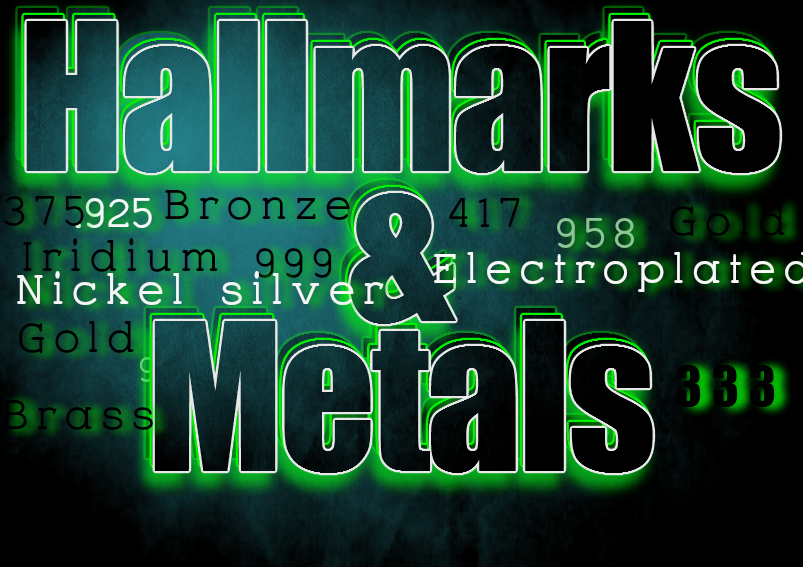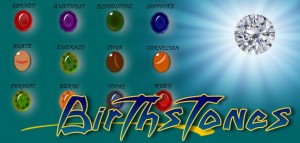Hallmarks and Metals
Base metal, pot metal, white metal
Any combination of any alloys of non-precious metals.
Brass Metal
An alloy of copper and zinc which has a yellow dark gold colour.
Bronze Metal
A brownish alloy of copper and tin that is not used much in costume jewelry because it is very dense and
heavy.
Electroplated
Jewelry can be mechanically plated with gold or silver in a variety of ways, including electroplated. Eventually, the gold plating wears away, but it depends on how often the item is worn and how thick the plating is.
Gold Hallmarks
|
Metal |
Percentage |
Hallmarks Number |
|
8 Karat Gold |
33.3 % |
333 |
|
9 Karat Gold |
37.5 % |
375 |
|
10 Karat Gold |
41.7% |
417 |
|
14 Karat Gold |
58.5 % |
585 |
|
18 Karat Gold |
75 % |
750 |
|
22 Karat Gold |
91.6 % |
916 |
|
24 Karat Gold |
99.9 % |
999 |
Gold is the most malleable and ductile metal known to man. Going back through time, gold has a special symbolic meaning depending on the culture.
A karat is a measure of the purity of the metal used in the making of jewellery. It is called a precious metal because it has a high economic value and is relatively scarce in relation to the level of demand for it. Gold has been the preferred metal for wedding rings in the west for a long time.
The purest gold specimens have a pure metal ratio of 96 to 99 per cent.. The higher the karat rating is, the higher the proportion of pure gold. Pure gold is 24K. When you hear everyone talk about solid gold this is when it exists in the earth and then mined in its pure form.
· Goldfilled, or gold-filled, abbreviated g.f. is lower in gold content than 10 KT, usually 1/20 or 1/12 KT.In this technique a sheet of gold is mechanically applied to the surface. Victorian pieces are likely to be unmarked, but later pieces are marked with the fineness of the gold layer, and the part by weight of the gold.. An older unmarked gold piece may often be identified by wear through to base metal. Look for a change to a darker, brassy colored material at these spots.
· Goldplate – A layer of gold applied to base metal, usually by electroplating. This is usually a very thin layer, only a few microns, which is likely to wear much more quickly than gold-filled.Not usually hallmarked
· Gold Tone – Gold colored or electro-plated, not gold.
Iridium
A metal from the platinum family, it is often alloyed with platinum to improve workability.
Nickel silver
A white metal mixture of copper, zinc, and nickel which contains no silver. Nickle silver has been reknown for causing allergic reactions. Not hallmarked
Pewter
Pewter items are described and marked as such if they contain at least 90% tin. Also, a somewhat dull silver-colored alloy of tin, antimony, and copper.
Rhodium
A metal from the platinum family. Silver, gold, and even base metals were often Rhodium plated during the 30’s and 40’s to give them the white, shiny look associated with platinum. Genuine rhodium in raw state is liquid. Although in the platinum family of metals, it is not the same as platinum which is a solid precious metal.
Rhodium-plating
A thin plating of rhodium, which is one of the members of the platinum family, applied over either sterling or other alloy to give a bright, shiny, long lasting silver-colored finish to a piece.
SilverTone
Silver plated or coated, not sterling silver. Just a silver colour.
Sterling Silver Hallmarks
|
Metal |
Percentage |
Hallmark Number |
|
Sterling Silver |
92.5 % |
925 |
|
Britannia |
95.8% |
958 |
Sterling Silver Jewelry has always been popular precious metal in ancient legends and throughout history in every country. While silver is used in lots of products, its use as money and sterling silver jewelry are the source of its mystique and intrigue.
Sterling silver jewelry comes in an amazing variety of styles and textures over its 4,000 year history. Sterling silver jewellery attracts you to its highly polished surface that reflects the light in a way like no other jewelry does. Another finish applied to sterling silver jewelry is rhodium that gives it a slightly darker finish.
The term sterling silver jewellery refers to jewelry cast from 92.5% silver. This is because 100 % pure sterling silver jewellery is a little soft and prone to bending and breaking, so other metals like nickel or tin but copper is used the most. This is why sterling silver tarnishes, especially when copper is used. Keep a soft cloth and silver polish and handy to keep your sterling silver jewelry shining bright.
Titanium
To many people, titanium is a mysterious term. General understanding for this metal is that it is a very hard substance, it is very light as well. Titanium is hyperallergenic, there alloys are inert and does not contain nickel or cobalt which most people with more sensitive skin are allergic to.
Troy Weight
Gold and silver are measured in Troy weight, a system that includes pennyweights, ounces and pounds. Gold is also commonly measured in metric grams. A pennyweight (abbreviated dwt.) is equal to 1.5552 grams.




